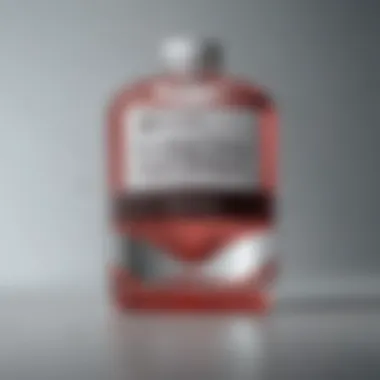Hydrogen Peroxide for Cystic Acne: An In-Depth Examination


Intro
Cystic acne is a condition that affects many individuals, causing not only physical discomfort but also emotional distress. Understanding the treatment options available is crucial for those suffering from this form of acne. One treatment that has gained interest is hydrogen peroxide. This article provides a detailed examination of hydrogen peroxide's role in managing cystic acne, delving into its properties, mechanisms of action, and guidelines for appropriate use.
Chemical Properties of Hydrogen Peroxide
Hydrogen peroxide is a simple molecule consisting of two hydrogen atoms and two oxygen atoms. Its chemical structure allows it to possess strong oxidizing properties. In the context of skincare, particularly for acne treatment, hydrogen peroxide is celebrated for its ability to kill bacteria and act as a mild antiseptic. This can result in reduced inflammation and quicker healing of breakouts, essential for those dealing with cystic acne.
Mechanisms of Action
The primary mechanism by which hydrogen peroxide interacts with acne is through its antibacterial properties. It targets Propionibacterium acnes, the bacteria commonly associated with acne, helping to prevent the formation of new cystic lesions. Furthermore, hydrogen peroxide may also have a moderate exfoliating effect, promoting skin renewal and preventing clogged pores. Understanding these mechanisms is crucial in assessing its overall effectiveness as a treatment option.
Benefits of Hydrogen Peroxide
Using hydrogen peroxide for cystic acne has several advantages:
- Bacterial reduction: It helps in reducing acne-causing bacteria.
- Fast acting: Results may be visible relatively quickly compared to some traditional treatments.
- Accessibility: Hydrogen peroxide is widely available and often inexpensive.
Drawbacks of Hydrogen Peroxide
However, potential drawbacks should also be considered:
- Skin irritation: Hudson peroxide can cause dryness, redness, or peeling, particularly for sensitive skin types.
- Discoloration: It has the potential to lighten skin tone or fabric, which is vital to keep in mind.
Proper Usage Guidelines
Proper use of hydrogen peroxide is essential to maximize benefits while minimizing side effects. Here are some tips:
- Concentration: Use low concentrations (around 3%) to avoid excessive irritation.
- Patch test: Always perform a patch test on a small area to gauge skin reaction.
- Frequency: Limit application to once daily, gradually increasing if tolerated well.
Epilogue
Incorporating hydrogen peroxide into a skincare routine for cystic acne can be beneficial, given its antibacterial properties and potential for fast results. However, it is important to approach its use with caution, understanding both the benefits and the risks involved. This mixture of insights will assist individuals in making informed decisions about their skincare regimen, catering to their specific needs.
Prelims to Cystic Acne
Cystic acne is a severe form of acne that can result in significant discomfort and emotional distress for those affected. Understanding cystic acne is critical for various reasons, particularly for women of all ages. This article aims to offer detailed insights into the nature of cystic acne, the underlying factors that contribute to its development, as well as the available treatment options.
Definition and Characteristics
Cystic acne is characterized by deep, inflamed lesions that may appear as large, red bumps on the skin. These cysts are typically painful and can lead to scarring if not managed properly. Unlike more common forms of acne, such as blackheads or whiteheads, cystic acne occurs when oil and bacteria clog the hair follicles beneath the skin. When these clogged pores become infected, they can fill with pus, resulting in the swollen cysts that are painful and unsightly.
Causes and Risk Factors
Several factors can contribute to the onset of cystic acne. Hormonal fluctuations, particularly during puberty or menstruation, play a significant role in the development of this skin condition. Increased oil production, often stimulated by hormonal changes, can lead to blocked pores. Additionally, genetic predisposition may influence one’s likelihood of developing cystic acne. Certain medications, as well as specific cosmetic products, can exacerbate the condition or trigger breakouts. Lifestyle choices, including diet and stress levels, also have an influence on skin health.
In summary, cystic acne is more than a mere cosmetic issue; it encompasses a range of complexities. By understanding its definition, characteristics, causes, and risk factors, readers can better appreciate the significance of effective treatment options, including the potential use of hydrogen peroxide in managing this challenging skin condition.
Understanding Hydrogen Peroxide
Hydrogen peroxide is an important topic when discussing treatments for cystic acne. This compound acts as an antiseptic and has properties that may be beneficial for skincare. Knowing its specific attributes is crucial for anyone considering its use in acne treatment. The mix of antimicrobial benefits with its availability makes hydrogen peroxide a notable option. However, recognizing both its positive and negative effects is essential. This ensures safe use and maximizes efficacy without compromising skin health.
Chemical Properties
Hydrogen peroxide is a simple chemical compound composed of two hydrogen atoms and two oxygen atoms, represented as O2. This molecular structure gives it unique properties. It is a colorless liquid that displays strong oxidative capabilities. These properties enable hydrogen peroxide to release oxygen when it decomposes. This makes it a potent antimicrobial agent against various microorganisms. The strength of its oxidizing power contributes to its effectiveness in reducing acne-causing bacteria on the skin.


Moreover, hydrogen peroxide often comes in various concentrations, typically ranging from 3% to 35%. The concentration affects its suitability for different applications. For skincare, the 3% solution is the most common, as it is safer for topical use. Understanding these chemical properties is vital for anyone considering hydrogen peroxide as a treatment.
Common Uses in Healthcare
Hydrogen peroxide has diverse applications in healthcare beyond treating acne. These uses include:
- Antiseptic for Minor Cuts: It is widely used to cleanse minor wounds to prevent infection.
- Oral Hygiene: Diluted hydrogen peroxide is sometimes used in mouth rinses to reduce bacteria in the oral cavity.
- Disinfectant: It serves as a disinfectant for medical instruments and surfaces because of its ability to kill germs.
- Skin Treatment: Its antibacterial properties make it suitable for managing skin conditions, including acne and other forms of dermatitis.
In the context of cystic acne, the relevance of hydrogen peroxide expands. It may aid in controlling bacterial growth and reducing inflammation. Leveraging these common uses can provide insight into how hydrogen peroxide might fit into a larger acne treatment regimen. Overall, its attributes and roles in healthcare highlight the potential benefits and considerations associated with its use.
Mechanisms of Action Against Acne
Understanding the mechanisms of action of hydrogen peroxide against cystic acne is pivotal. This knowledge not only offers insight into how this compound works but also helps users maximize its effectiveness while minimizing risks. Hydrogen peroxide presents dual action characteristics that make it a notable choice for skin treatment. Its antimicrobial properties and anti-inflammatory effects play crucial roles in mitigating acne symptoms. Each mechanism contributes to overall skin health and aids in improving the condition of cystic acne.
Antimicrobial Activity
Hydrogen peroxide is known for its strong antimicrobial activity. When applied to the skin, it releases oxygen free radicals. These radicals are highly reactive molecules that target and destruct harmful bacteria on the skin's surface. Active bacteria, particularly Propionibacterium acnes, thrive in the clogged pores of individuals suffering from cystic acne. By eliminating these bacteria, hydrogen peroxide significantly reduces the chances of acne flare-ups.
Key features of its antimicrobial action include:
- Effective against a broad spectrum of bacteria: It can target multiple strains, ensuring comprehensive coverage.
- Short exposure time required: Many users may only need a few seconds of contact for effective action.
However, one must exercise caution. The concentration of hydrogen peroxide is critical. A solution that is too strong can cause skin irritation. Therefore, it is advisable to use lower concentrations, such as 3%, in skincare routines. This balances effectiveness with safety.
Anti-inflammatory Properties
In addition to fighting bacteria, hydrogen peroxide displays notable anti-inflammatory properties. Inflammation is a significant concern in cystic acne, often exacerbating skin distress and redness. By reducing inflammation, hydrogen peroxide helps to calm irritated skin. This effect provides immediate relief to individuals suffering from painful cystic acne lesions.
The key benefits of its anti-inflammatory properties include:
- Reduced redness and swelling: This is instrumental in improving the visual aspect of cystic acne.
- Enhanced healing: Less inflammation can lead to quicker recovery times for affected areas.
Integrating hydrogen peroxide into an acne treatment regimen may therefore yield improved outcomes for many users. Nevertheless, one should monitor skin responses closely. Side effects like dryness can arise from overuse.
By understanding these mechanisms of action, individuals can better navigate their skincare choices. It's essential to consider both the benefits and potential drawbacks when applying hydrogen peroxide. This empowers users to make informed decisions that align with their unique skincare needs.
Benefits of Hydrogen Peroxide for Cystic Acne
Hydrogen peroxide has gained attention in the skincare community, especially regarding its use for cystic acne management. Cystic acne, known for its inflamed and painful lesions, demands effective treatment options. Hydrogen peroxide stands out due to its unique chemical properties and multiple mechanisms of action. This section explores its merits, detailing how it can improve skin and complement other treatments effectively.
Effective Spot Treatment
When addressing cystic acne, targeted treatment is vital. Hydrogen peroxide can serve as a powerful spot treatment, effectively reducing the size and inflammation of painful cysts. Its antiseptic nature helps diminish the bacteria at the site of application, reducing potential breakout severity.
To use hydrogen peroxide as a spot treatment, you should apply a small amount directly to the affected area using a cotton swab. It’s crucial to use a lower concentration, ideally 3%, to minimize the risk of skin irritation. This localized approach allows for more controlled outcomes while addressing the specific cyst.
Reduction in Bacteria Growth
One of the primary contributors to acne development is bacterial overgrowth, particularly Propionibacterium acnes. Hydrogen peroxide aids in reducing these bacteria, thanks to its oxidation properties. By introducing oxygen to the skin, it creates an environment less favorable for bacterial proliferation.
The effectiveness of hydrogen peroxide against bacteria can be attributed to its ability to release free radicals. This process not only targets the acne-causing bacteria but also helps in preventing future outbreaks. Users often notice a decrease in cyst severity and frequency upon regular application.
Complementing Other Treatments
Hydrogen peroxide can be effectively integrated into a broader acne treatment regimen. While it acts as a spot treatment by itself, it also enhances the efficacy of other topical treatments. For instance, using hydrogen peroxide before applying topical retinoids can improve penetration and effectiveness. Additionally, it works well alongside benzoyl peroxide, creating a multi-faceted approach to cystic acne treatment.
However, it is essential to note that one should consult with a dermatologist before combining treatments. This step ensures that the individual’s skin type and acne severity are considered, allowing for a tailored skincare routine that maximizes benefits while reducing the risk of irritation.


"Hydrogen peroxide, when used correctly, can be a simple yet effective tool in the arsenal against cystic acne."
Potential Drawbacks and Risks
While hydrogen peroxide can offer benefits in treating cystic acne, it bears potential drawbacks and risks that are essential to acknowledge. Understanding these risks is crucial in making informed decisions about acne treatment. Below, we will delve into two primary concerns: skin irritation and oxidative damage. A balanced perspective will help users weigh the pros and cons before incorporating hydrogen peroxide into their skincare regimen.
Skin Irritation
Skin irritation is a prominent concern when using hydrogen peroxide, especially for people with sensitive skin. Hydrogen peroxide is a powerful oxidizing agent. When applied topically, it may disrupt the skin's natural barrier. This disruption can lead to redness, itching, and peeling of the skin. It is important to note that irritation can range from mild to severe, depending on the concentration of the solution and the frequency of application.
When introducing hydrogen peroxide into your skincare routine, it is advisable to start with a diluted solution. A concentration of 1-3 percent is commonly used for acne treatment. Performing a patch test on a small skin area can help determine individual tolerance. If any sign of irritation occurs, discontinuing use is recommended.
"Understanding your skin's reaction is key to safe treatment."
Moreover, users with pre-existing skin conditions such as eczema or psoriasis may experience heightened sensitivity. Caution is advised for individuals who have open wounds or sunburns, as hydrogen peroxide can exacerbate these conditions.
Oxidative Damage
Another risk associated with hydrogen peroxide usage is oxidative damage to the skin. Although hydrogen peroxide's antimicrobial properties make it appealing for treating cystic acne, it can lead to unintended consequences. Overuse or high concentrations can foster oxidative stress, leading to cellular damage and accelerated aging of the skin. This occurs due to the excessive production of free radicals, which can harm collagen and elastin fibers.
To mitigate these risks, users should adhere to recommended usage guidelines. Consulting with a dermatologist can also provide insights tailored to individual skin types. Always remember that while hydrogen peroxide may help clear pimples and reduce inflammation, it should be part of a broader skincare strategy that considers overall skin health.
How to Use Hydrogen Peroxide Safely
Using hydrogen peroxide effectively in the treatment of cystic acne requires an understanding of safety protocols. As a powerful antiseptic and oxidizing agent, hydrogen peroxide can provide benefits, but it also carries risks if not used properly. This section outlines fundamental considerations, including dilution, application techniques, and frequency of use. A careful approach can maximize the treatment's effect while minimizing potential side effects.
Dilution Guidelines
Hydrogen peroxide in high concentrations can cause skin irritation. To avoid this, diluting the solution is essential. Generally, a 3% solution is recommended for topical use. Here’s how to dilute:
- Ratio: Mix one part hydrogen peroxide with one part water.
- Test the Mixture: Before full application, conduct a patch test on a small area of skin to ensure no adverse reaction occurs.
- Storage: Store diluted solutions in a dark container to prevent breakdown from light.
It's important to note that higher concentrations, like 30% or 35%, should be avoided for skin application due to the risk of burns and irritation.
Application Techniques
The method of applying hydrogen peroxide can influence its effectiveness. Here are steps to apply safely:
- Cleanse the Skin: Wash your face with a gentle cleanser. This removes dirt and excess oil, creating a suitable base for treatment.
- Use a Cotton Swab: Dab a cotton swab in the diluted hydrogen peroxide solution. This targets specific acne spots without spreading to surrounding areas.
- Pat, Don't Rub: Gently pat the solution onto the acne. Rubbing can irritate the skin further. Allow it to dry naturally without rinsing off.
- Moisturize: Follow with a non-comedogenic moisturizer. This helps keep the skin hydrated and mitigates dryness that may result from hydrogen peroxide.
Always avoid contact with eyes and mucous membranes. If irritation occurs, discontinue use immediately.
Frequency of Use
Determining the right frequency for using hydrogen peroxide is crucial for achieving favorable results without damaging the skin. Here are some recommendations:
- Start Slowly: Use it once every other day to assess how your skin reacts. This helps in gauging sensitivity.
- Adjust Frequency: Depending on your skin's tolerance, you may increase to once daily if desired results are not achieved.
- Breaks are Important: Allow the skin to rest. Using hydrogen peroxide continuously without breaks may lead to over-drying or irritation.
Monitoring your skin's response is critical. Should any significant irritation occur, reduce usage or consult with a dermatologist.
In summary, using hydrogen peroxide for cystic acne effectively requires a mindful approach to dilution, application techniques, and usage frequency. Adhering to these guidelines ensures safer integration into your skincare routine.
Alternatives to Hydrogen Peroxide in Acne Treatment
When addressing cystic acne, individuals are often on the lookout for effective treatments. While hydrogen peroxide has been discussed extensively, it’s essential to explore alternatives that might offer similar benefits without the potential drawbacks. Various products and methods can serve as viable options for managing cystic acne, each with its unique properties and effectiveness.


Understanding these alternatives helps in making informed decisions. Some treatments can target similar mechanisms as hydrogen peroxide, addressing the underlying causes of acne such as bacteria growth, inflammation, and clogged pores. Moreover, knowing these alternatives can empower individuals to customize their skincare routine according to their skin type and overall sensitivity.
Topical Retinoids
Topical retinoids, derived from vitamin A, are widely recognized for their role in acne management. Medications like tretinoin and adapalene are common examples. These compounds promote cell turnover, allowing clogged pores to clear. By preventing dead skin cells from accumulating, retinoids can significantly reduce the formation of cysts.
Additionally, retinoids possess anti-inflammatory properties. They help to calm existing lesions and improve skin texture over time. However, patients must approach this category of treatment with caution due to the potential for skin irritation, especially in the early stages of use. It’s advisable to start with a lower concentration and gradually increase usage for better tolerance.
Benzoyl Peroxide
Benzoyl peroxide is another alternative that effectively tackles acne-causing bacteria. This compound works by introducing oxygen into the pores. The bacteria that thrive in low-oxygen environments are thus eliminated. Benzoyl peroxide also has keratolytic properties, meaning it helps in shedding dead skin cells, further preventing clogged pores.
While generally effective, benzoyl peroxide can lead to dryness and peeling. To mitigate these side effects, one can consider formulations that include moisturizers. Starting with a lower concentration—such as 2.5%—can also aid in gauging skin reaction before progressing to higher strengths.
Salicylic Acid
Salicylic acid is a beta hydroxy acid renowned for its gentle yet effective exfoliating properties. It penetrates the skin's surface, dissolving debris and excess oil that can lead to cystic acne. Salicylic acid is particularly beneficial for oily and acne-prone skin types, as it helps to unclog pores without causing harsh irritation.
Furthermore, salicylic acid possesses anti-inflammatory effects, which can soothe active cystic lesions. It is often found in various over-the-counter products, such as cleansers and topical treatments. Due to its milder nature, it can be incorporated more readily into a skincare regimen without the intense side effects seen with stronger treatments.
Consulting with a Dermatologist
Cystic acne poses significant challenges for those who suffer from it. Consulting with a dermatologist is pivotal for anyone dealing with this severe acne. This specialist provides insights that can enhance treatment efficacy and skin health overall.
Importance of Professional Guidance
Professional guidance is essential when attempting to manage cystic acne. Dermatologists have experience and training that allows them to evaluate individual skin types and conditions accurately. This knowledge can help in selecting the right treatments based on a person’s unique skin characteristics.
Considering the variety of treatments available, a dermatologist can help narrow down the options that are most likely to be effective and safe. They may recommend hydrogen peroxide as part of a treatment plan or suggest alternatives that could be more suitable based on the individual's situation.
Moreover, dermatologists can monitor the progress and adjust treatments as necessary. They can recognize any adverse reactions early, preventing potential damage or worsening of the skin. This adaptive approach ensures that the pathways for achieving clear skin are safe and effective, ultimately saving time and resources.
Diagnosing Skin Conditions
Correct diagnosis is vital for effective treatment. Cystic acne can sometimes be confused with other skin disorders like hormonal acne or rosacea. A dermatologist can perform a thorough assessment of the skin and may even conduct tests if necessary.
When analyzing skin conditions, dermatologists look for several factors:
- Skin Type: Oily, dry, or combination skin can influence treatment choices.
- Severity: Understanding the severity of the condition helps in planning appropriate interventions.
- Underlying Causes: Hormonal imbalances or dietary influences may need to be addressed.
Clarifying these factors with a professional enhances the overall treatment strategy. Receiving the right diagnosis also empowers individuals with the knowledge they need to combat cystic acne efficiently.
"A well-informed treatment approach can significantly reduce the stress associated with cystic acne. Consulting a dermatologist is the first step toward reclaiming your skin health."
By investing time in consulting with a dermatologist, individuals create a solid foundation in their skincare journey, dramatically increasing the chances of lasting results.
Closure
The conclusion serves a critical role in synthesizing the insights from this article regarding the use of hydrogen peroxide for treating cystic acne. Summing up the diverse aspects of the topic helps readers understand the relevance of hydrogen peroxide in skincare, particularly for those suffering from severe acne. The combination of its antimicrobial and anti-inflammatory properties can provide valuable support in combating cystic acne. However, this conclusion also emphasizes the importance of caution when using hydrogen peroxide, as improper use may cause skin irritation or oxidative damage.
Summary of Key Points
In summary, several key elements highlighted in this article are essential for comprehending the overall discussion:
- Chemical Properties: Hydrogen peroxide is a mild antiseptic with strong oxidizing capabilities. Its role in acne treatment stems from its ability to kill bacteria on the skin.
- Mechanisms of Action: It works by reducing bacterial counts and mitigating inflammation, both significant contributors to cystic acne.
- Benefits: Effective as a spot treatment, hydrogen peroxide also complements other acne treatments, enhancing overall effectiveness.
- Drawbacks: Despite its benefits, concerns including skin irritation and potential for oxidative damage remain prevalent, necessitating careful monitoring during usage.
- Usage Guidelines: Adhering to proper dilution, application techniques, and usage frequency is paramount in minimizing risks associated with hydrogen peroxide.
Final Considerations
As individuals explore options for cystic acne treatment, it is vital to approach hydrogen peroxide with both optimism and caution. While it can be an effective tool in a broader skincare regimen, knowing one’s skin type, potential sensitivities, and specific conditions is crucial. Consulting a dermatologist offers necessary professional guidance, ensuring the chosen treatment aligns with an individual’s unique skincare needs. As always, informed decisions based on substantial knowledge will lead to improved outcomes in managing cystic acne effectively.
"Hydrogen peroxide is not just a household item; its applications in skincare reveal a deeper understanding of its therapeutic potential."
In closing, this examination highlights the necessity for a balanced perspective when integrating hydrogen peroxide into treatment plans. By weighing both its benefits and risks, and relying on professional insight, individuals can navigate their skincare journeys with greater confidence and efficacy.







